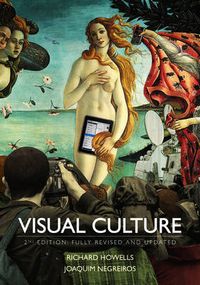
endast ny
Visual Culture Upplaga 1
This is a revised, expanded, and updated edition of the highly successful Visual Culture. Like its predecessor, this new version is about visual literacy, exploring how meaning is both made and transmitted in an increasingly visual world. It is designed to introduce students and other interested readers to the analysis of all kinds of visual text, whether drawings, paintings, photographs, films, advertisements, television or new media forms. The book is illustrated with examples that range from medieval painting to contemporary advertising images, and is written in a lively and engaging style. The first part of the book takes the reader through differing theoretical approaches to visual analysis, and includes chapters on iconology, form, art history, ideology, semiotics and hermeneutics. The second part shifts from a theoretical to a medium-based approach and comprises chapters on fine art, photography, film, television and new media. These chapters are connected by an underlying theme about the complex relationship between visual culture and reality. New for the second edition are ten more theoretically advanced Key Debate sections, which conclude each chapter by provoking readers to set off and think for themselves. Prominent among the new provocateurs are Kant, Baudrillard, Althusser, Deleuze, Benjamin, and Foucault. New examples and illustrations have also been added, together with updated suggestions for further reading. The book draws together seemingly diverse approaches, while ultimately arguing for a polysemic approach to visual analysis. Building on the success of the first edition, this new edition continues to provide an ideal introduction for students taking courses in visual culture and communications in a wide range of disciplines, including media and cultural studies, sociology, art and design.
Upplaga: 1a upplagan
Utgiven: 2012
ISBN: 9780745650708
Förlag: John Wiley & Sons
Format: Häftad
Språk: Engelska
Sidor: 300 st
This is a revised, expanded, and updated edition of the highly successful Visual Culture. Like its predecessor, this new version is about visual literacy, exploring how meaning is both made and transmitted in an increasingly visual world. It is designed to introduce students and other interested readers to the analysis of all kinds of visual text, whether drawings, paintings, photographs, films, advertisements, television or new media forms. The book is illustrated with examples that range from medieval painting to contemporary advertising images, and is written in a lively and engaging style. The first part of the book takes the reader through differing theoretical approaches to visual analysis, and includes chapters on iconology, form, art history, ideology, semiotics and hermeneutics. The second part shifts from a theoretical to a medium-based approach and comprises chapters on fine art, photography, film, television and new media. These chapters are connected by an underlying theme about the complex relationship between visual culture and reality. New for the second edition are ten more theoretically advanced Key Debate sections, which conclude each chapter by provoking readers to set off and think for themselves. Prominent among the new provocateurs are Kant, Baudrillard, Althusser, Deleuze, Benjamin, and Foucault. New examples and illustrations have also been added, together with updated suggestions for further reading. The book draws together seemingly diverse approaches, while ultimately arguing for a polysemic approach to visual analysis. Building on the success of the first edition, this new edition continues to provide an ideal introduction for students taking courses in visual culture and communications in a wide range of disciplines, including media and cultural studies, sociology, art and design.
Ny bok
988 kr1039 kr
5% studentrabatt med Studentapan
Begagnad bok (0 st)
Varje vecka tillkommer tusentals nya säljare. Bevaka boken så får du meddelande när den finns tillgänglig igen.



